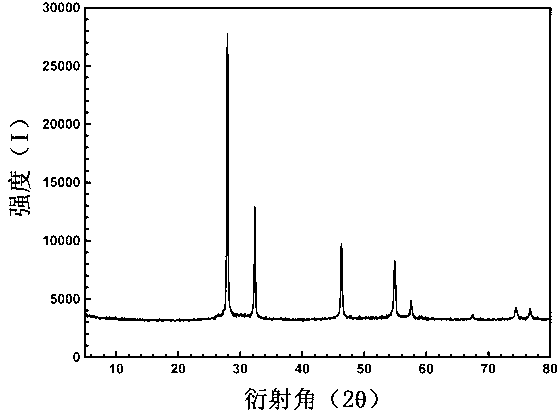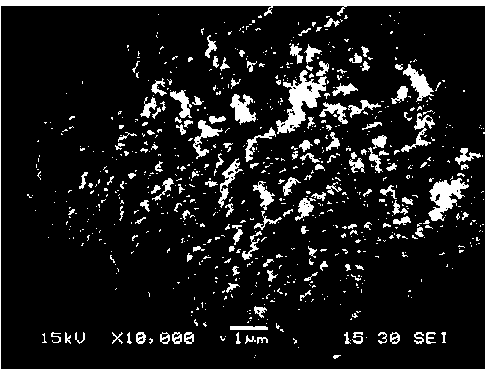Bismuth tungstate nanocrystal and preparation method thereof
A nano-grain, bismuth tungstate technology, applied in nanotechnology, chemical instruments and methods, tungsten compounds, etc.
- Summary
- Abstract
- Description
- Claims
- Application Information
AI Technical Summary
Problems solved by technology
Method used
Image
Examples
Embodiment 1
[0023] Add 1.2 grams of bismuth sulfate to 0.6 milliliters of concentrated nitric acid, add 15 milliliters of deionized water after initial stirring, stir to dissolve and dilute, and record it as solution A. In addition, 0.55 g of ammonium paratungstate decahydrate was added to 30 ml of deionized water, stirred and dissolved, and recorded as solution B.
[0024] Add solution A to solution B dropwise and stir while adding to form a homogeneous suspension. Adjust the pH of the solution to approximately 8 with 20% ammonia water. Then aged at 368K for 24 hours in a closed state. After aging, the precipitated product is washed with a large amount of deionized water, and dried to obtain bismuth tungstate nanocrystals.
[0025] The crystal form of the prepared bismuth tungstate (Bi3.84W0.16O6.24) is consistent with the standard powder diffraction card (JCPDS: 43-0447). Above 99%.
Embodiment 2
[0027] Add 1.5 grams of bismuth nitrate pentahydrate into 0.8 milliliters of concentrated nitric acid, add 20 milliliters of deionized water after preliminary stirring, stir to dissolve and dilute, and record it as solution A. In addition, 0.5 g of sodium tungstate monohydrate was added to 40 ml of deionized water, stirred and dissolved, and recorded as solution B.
[0028] Add solution A to solution B dropwise and stir while adding to form a homogeneous suspension. Adjust the pH of the solution to approximately 9 with 25% ammonia water. Then aged for 48 hours at a temperature of 353K in a closed state. After aging, the precipitated product is washed with a large amount of deionized water, and dried to obtain bismuth tungstate nanocrystals.
[0029] The crystal form of the prepared bismuth tungstate (Bi3.84W0.16O6.24) is consistent with the standard powder diffraction card (JCPDS: 43-0447). Above 99%.
Embodiment 3
[0031] Add 3.0 grams of bismuth oxycarbonate to 1.2 milliliters of concentrated nitric acid, add 35 milliliters of deionized water after preliminary stirring, stir to dissolve and dilute, and record it as solution A. In addition, 1.2 grams of potassium paratungstate octahydrate was added to 90 ml of deionized water, stirred and dissolved, and recorded as solution B.
[0032] Add solution A to solution B dropwise and stir while adding to form a homogeneous suspension. Adjust the pH of the solution to about 9 with 10% ammonia water. Then aged at a temperature of 333K for 72 hours in a closed state. After aging, the precipitated product is washed with a large amount of deionized water, and dried to obtain bismuth tungstate nanocrystals.
[0033] The crystal form of the prepared bismuth tungstate (Bi3.84W0.16O6.24) is consistent with the standard powder diffraction card (JCPDS: 43-0447). Above 99%.
PUM
| Property | Measurement | Unit |
|---|---|---|
| Diameter | aaaaa | aaaaa |
| Diameter | aaaaa | aaaaa |
| Diameter | aaaaa | aaaaa |
Abstract
Description
Claims
Application Information
 Login to View More
Login to View More - R&D
- Intellectual Property
- Life Sciences
- Materials
- Tech Scout
- Unparalleled Data Quality
- Higher Quality Content
- 60% Fewer Hallucinations
Browse by: Latest US Patents, China's latest patents, Technical Efficacy Thesaurus, Application Domain, Technology Topic, Popular Technical Reports.
© 2025 PatSnap. All rights reserved.Legal|Privacy policy|Modern Slavery Act Transparency Statement|Sitemap|About US| Contact US: help@patsnap.com



